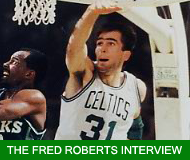The Fred Roberts Interview
By:
Michael D. McClellan
|
Tuesday, March 6th, 2012
The sports world has always been a
star-driven universe, the imaginations of its fans fueled by extraordinary
performances under pressure: Joe Montana's precision passing in the Super
Bowl, David Beckham's
 creative shot-making in the World Cup, Albert Pujols'
towering home runs in the World Series. The stars sell the tickets and the
jerseys, and they drive television revenue through the ceiling in the
process. Larry and Magic arrived when fan interest in professional
basketball at an all-time low; their battles sparked the NBA's Golden Age,
and the league transformed itself into a global marketing machine thanks in
large part to their epic rivalry. And the same can be said for individual
sports – in golf there has always been an Arnold Palmer, or a Jack Nicklaus,
or a Tiger Woods, their larger-than-life personas filling the galleries and
attracting the sponsors. Imagine tennis without the historic achievements of
players like McEnroe, Sampras, Agassi or Federer. Would we even care about
the Tour de France without Lance Armstrong?
creative shot-making in the World Cup, Albert Pujols'
towering home runs in the World Series. The stars sell the tickets and the
jerseys, and they drive television revenue through the ceiling in the
process. Larry and Magic arrived when fan interest in professional
basketball at an all-time low; their battles sparked the NBA's Golden Age,
and the league transformed itself into a global marketing machine thanks in
large part to their epic rivalry. And the same can be said for individual
sports – in golf there has always been an Arnold Palmer, or a Jack Nicklaus,
or a Tiger Woods, their larger-than-life personas filling the galleries and
attracting the sponsors. Imagine tennis without the historic achievements of
players like McEnroe, Sampras, Agassi or Federer. Would we even care about
the Tour de France without Lance Armstrong?
But sports cannot exist on stars alone. For every Wayne Gretzky there are
hundreds of grinders doing their best to make a roster, to make a
contribution, to make a living doing what they love to do the most. You see
them every time you turn on the TV to watch your favorite team. You cheer
for them make a big play, or sometimes just to see them get into the game.
Some of them flash briefly across the sky, only to get cut or injured and
disappear from view forever. But others have staying power. These are the
athletes that have both the talent and the luck to persevere, and they know
their place in the sports universe. They do their jobs and are always ready
when called upon, and they forge a successful career as a professional
athlete.
Fred Roberts is such a man. Roberts played his college basketball at Brigham
Young University during the late 70s and early 80s, and even at the
collegiate level he could be described as anything but a star. That mantle
went to teammate Danny Ainge, who would be named college basketball's player
of the year as a senior. But Roberts was long and athletic and could run the
court, and he worked hard to improve his game. He played in 119 games for
the Cougars, averaging 15.5 points and seven rebounds while shooting 54.6%
from the field. His contributions helped to spark a basketball renaissance
at BYU, and in the process he garnered the attention of NBA scouts, with the
Milwaukee Bucks taking him in the second round of the 1982 NBA Draft.
Roberts chose to play basketball in Europe rather than jump directly into
the NBA, a decision that would, ironically, add years to his career on the
back end; it was while playing in Italy that Roberts realized the value of
being in top physical shape and being able to run the floor, something he
was able to do for parts of 13 NBA seasons.
While in Italy, Roberts was traded from the Bucks to the New Jersey Nets,
who, in turn, would trade him to the San Antonio Spurs. The latter
transaction was also notable in that it involved a head coach – Stan Albeck
– one of the few times in the league history that a coach was a part of a
trade between teams.
